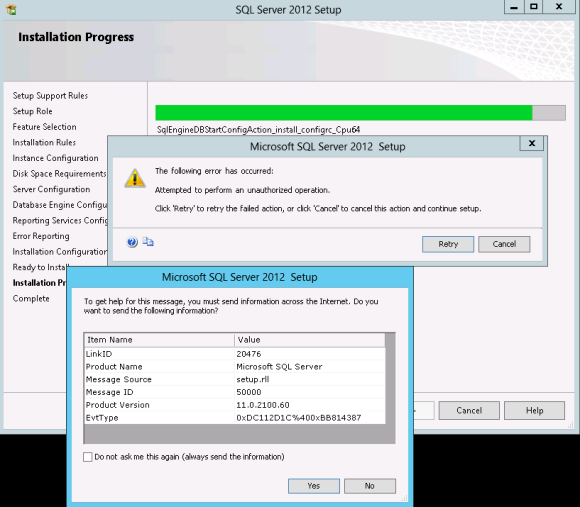LINQPad December 9, 2012
Posted by vmaceda in Uncategorized.Tags: LINQ, LINQPAD
add a comment
LINQPad is a C#/VB/F# scratchpad that instantly executes any expression, statement block or program with rich output formatting and a wealth of features that “just work”. This tool really works. To download: http://www.linqpad.net/
Configure Visual Studio 2012 to Run as Administrator November 13, 2012
Posted by vmaceda in Uncategorized.Tags: Visual Studio 2012 to Run as Administrator
add a comment
Windows Server 2012:
- Go to C:\Program Files (x86)\Microsoft Visual Studio 11.0\Common7\IDE
- Right click deven.exe->Properties
- On the Compatibility Tab click on the Advanced… button
- Tick on Run this program as an administrator
- Click on Change Settings for all user and tick on Run this program as an administrator
Windows 8:
- Go to C:\Program Files (x86)\Microsoft Visual Studio 11.0\Common7\IDE
- Right click deven.exe
- Select Troubleshoot program
- Check The program requires additional permissions
- Click Next, click Test the program…
- Wait for the program to launch
- Click Next
- Select Yes, save these settings for this program
- Click Close
The filtering process has been terminated – SharePoint 2013 Search Content Crawl November 13, 2012
Posted by vmaceda in Uncategorized.Tags: SharePoint 2013 Search Content Crawl
add a comment
This is cause by WSS_WPG group don’t have the correct permissions on C:\Program Files\Microsoft Office Servers\15.0\Data\Office Server\Applications , c:\Windows\Temp . It should have “Full Control”
Make sure that the search index location is in C:\Program Files\Microsoft Office Servers\15.0\Data\Office Server\Applications by Running the following in SharePoint 2013 Management Shell.
Re-install SharePoint 2013.
Cannot import the following key file November 13, 2012
Posted by vmaceda in Uncategorized.Tags: SharePoint 2010, SharePoint 2013
add a comment
The Error:
Cannot import the following key file: <filename>.pfx. The key file may be password protected. To correct this, try to import the certificate again or manually install the certificate to the Strong Name CSP with the following key container name: VS_KEY_ E2AEBF22AB52DD08 <Application Name>
The Fix:
- Open Visual Studio Command Prompt (It can be found in the Windows Start menu)
- Type sn -i “c:\Pathtofile\<filename>.pfx” VS_KEY_ E2AEBF22AB52DD08
- Reimport the pfx file into Visual Studio
The sn.exe with the –i parameter, installs a key pair from <infile> into a key container named <container>.
Upgrading SharePoint 2010 projects to 2013 November 13, 2012
Posted by vmaceda in Uncategorized.Tags: Upgrading SharePoint 2010 projects to 2013
add a comment
- Open your csproj in notepad.
- Change the Target Framework Version from v3.5 to v4.5 <TargetFrameworkVersion>v4.5</TargetFrameworkVersion>
- Set the Office Target Version to 15 by entering the following tag to the file below TargetFrameworkVersion tag. <TargetOfficeVersion>15.0</TargetOfficeVersion>
- Update all referenced assemblies;
- SharePoint assemblies from version 14.0.0.0 to 15.0.0.0
- .NET assemblies from 2.0 and 3.5 to 4.0 and 4.5
- Go to each file (eyeball and replace them one at a time):
- Replace all 14.0.0.0 in user controls and web parts to 15.0.0.0
- Replace all version 12.0.0.0 in Pagelayouts to 15.0.0.0. Look specifically at:
<%@Register TagPrefix=”SharePoint” Assembly=”Microsoft.SharePoint, Version=12.0.0.0, Culture=neutral, PublicKeyToken=71e9bce111e9429c” namespace=”Microsoft.SharePoint.WebControls”%> - Build the project to check for any compilation errors and re-adjust.
- Update list definitions to take advantage of the new view styles.
- For all user control and delegate references:Change from: ~/_controltemplates/..To: ~/_controltemplates/15/
- Change all reference of /_layouts/ to /_layouts/15/
- Go to the Package.Template.xml and add SharePointProductVersion=”15.0″
<?xml version=”1.0″ encoding=”utf-8″?>
<Solution xmlns=”http://schemas.microsoft.com/sharepoint/” SharePointProductVersion=”15.0″>
</Solution> - Make sure that the elements in package.package SharePoint Product Version is set to 15.0
Problem when installing SQL Server 2012 in Windows Server 2012 SqlEngineDBStartConfigAction_install_configrc_Cpu64 /setup.rll November 2, 2012
Posted by vmaceda in Uncategorized.Tags: setup.rll, SQL Server 2012, SqlEngineDBStartConfigAction_install_configrc_Cpu64, Windows Server 2012
add a comment
Related Error:
The following error has occurred:
Attempted to perform an unauthorized operation.
Click ‘Retry’ to retry the failed action, or click ‘Cancel’ to cancel this action and continue setup
SqlEngineDBStartConfigAction_install_configrc_Cpu64
Setup.rll
Solution:
Download Winrar. Do not use winzip or any iso program such as magic ISO to extract the ISO
Extract the ISO to a folder before installation
Run Setup.exe as Administrator,
Install it in drive C:
CAML Builder / Designer October 18, 2012
Posted by vmaceda in Uncategorized.Tags: CAML Builder, CAML Designer, SharePoint 2010, SharePoint 2013
add a comment
CAML (Collaborative Application Markup Language) is an XML-based query language that helps you querying and customizing SharePoint sites. The XML elements define various aspects of a SharePoint site.
Download it here
This version of the CAML designer contains the following functionality:
• Log on using the SharePoint server object model, or the SharePoint client object model, or the web services
• CAML snippets for querying a SharePoint list
• Code snippets for the SharePoint server object model, the .NET Client object, the SharePoint web services
Session 1: The Role of Information Architecture in Optimizing SharePoint Search and Navigation June 25, 2012
Posted by vmaceda in Uncategorized.Tags: Information Architecture, SharePoint
add a comment
Session 1: The Role of Information Architecture in Optimizing SharePoint Search and Navigation
